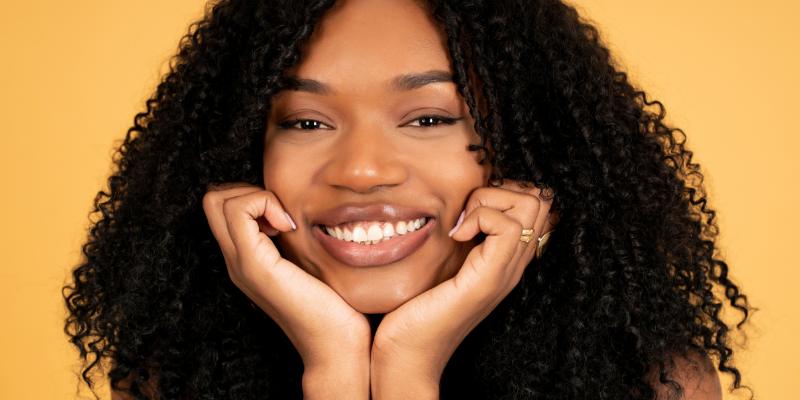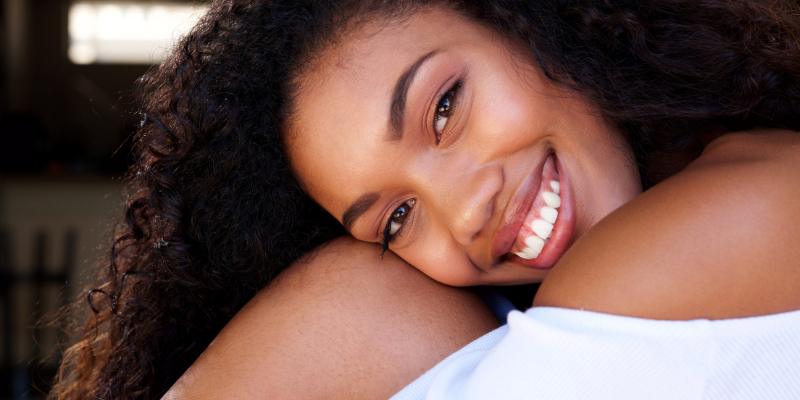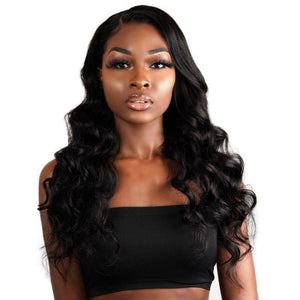Good Hair...So What?
When you see or hear the term 'good hair' what comes to mind?
We see black women with really long or curly hair, and for many people, that is their definition of what good hair is. You may even be guilty of telling black women with really long hair that "she has that good hair."
These comments need to stop. Good hair should not go by length or how someone's curls fall. If that is the association with the phrase, it is a phrase that people shouldn't use at all.
I am going to talk about how people commonly use the phrase, where it originates from, and how it should transform into a different meaning.

The Meaning of "Good Hair"
The phrase "good hair" isn't used to describe styles that look flawless.
It's solely a descriptor of texture and refers to black hair that is straight, wavy, or very loosely curled. The term demeans highly coiled afro-textured hair. "Good" hair is considered beautiful on its own, while highly textured styles must be pressed and permed to be considered something of beauty.
Though no one has specifically stated this, the heavy implication is that all kinky types of black hair are not "good hair." I am sure many of you have experienced this good hair debacle once in your life. Whether it has personally affected you or someone you know has gone through it. This "good hair" battle is much deeper than just hair in general.
This hair debate goes all the way back to slavery where there were mixed children with lighter skin and hair with a looser texture. Lighter skin and looser curls receive praise because they are closer to the European standard of beauty that offered no space for the dark-skinned and kinky-haired also to be considered beautiful. Whether or not natural hair is good enough is still a huge issue today that we are fighting to change. An example of this is in the workplace.
Many black women in the work field hear that their natural hair is not professional and have been told to change it. Can you imagine being told the hair that grows out of your hair is "unprofessional?"
European beauty standards still profoundly exist in America.
The battle of hair is an internal struggle for many women who are even embarrassed to flaunt their natural hair because of the fear of being reprimanded.
Nappy hair
A derogatory term we often hear to describe kinky African American hair is the phrase "nappy."
We all know what it means to be called nappy headed, and it is not a compliment. This term is offensive because of the history of African American hair. For a runaway slave, the kinks in her hair could mean the difference between freedom in the North and enslavement or worse if she were to be caught and returned to her master.
Because slaves had children by their white slave masters, miscegenation occurred. Miscegenation meant that some slaves had skin as light as whites and the rule of thumb was that hair was a more reliable indicator than the skin of a person's racial heritage.
Thus, runaway slaves often shaved their heads to get rid of any evidence of their ancestry and posters advertising for fugitive slaves often warned slave catchers to be on the lookout for runaways with shaved heads: "They might pass for white."
Another huge example with hair happened with Angela Davis. In the late 1960s, after the FBI declared Angela Davis one of the country's ten most wanted criminals, thousands of other law-abiding, Afro-wearing African-American women became targets of state repression. Black women were accosted, harassed, and arrested by police, the FBI, and immigration agents.
The "wanted" posters that featured Davis, her huge Afro framing her face like a halo, appeared in post offices and government buildings all over America, not to mention on television and in Life magazine. Her "nappy hair" served not only to structure popular opinions about her as a dangerous criminal, but also made it possible to deny the rights of due process and habeas corpus to any young black woman, just by her hairstyle. For centuries black women have been punished for something they cannot control.
It is time to throw away the terms good hair and nappy and realize that no matter what texture, we all have good hair.

Different Hair Types
What Causes Different Textures?
Everyone has a different hair pattern.
Here is the science behind it. The amount of curl, wave, or lack thereof in our hair is dependent on the number of disulfide bonds between hair proteins found in the hair shaft. Disulfide bonds are one of the most active naturally-occurring bonds in nature. The protein structures of the hair shaft are held together by chemical bonds called disulfide and hydrogen bonds.
While the curliness (or straightness) of your hair depends on the shape of the follicle, it's the disulfide bonds that keep the hair in the way it forms naturally. The higher the number of links, the curlier the hair, and the fewer the number of links, the straighter the hair. Hair is primarily composed of keratin, a protein, which grows from the follicle.
Keratins and other proteins formulate in the cells of the hair follicle. All of the proteins become a part of the hair shaft and contain sulfur atoms. When two sulfur atoms pair up and bond, they form a disulfide bond. If the two sulfur atoms in the same protein are at a distance and join to form the disulfide bond, the protein will bend.
This process is how your hair creates curls.
Texture chart
Andre Walker, who is Oprah's hair stylist, created a broad-spectrum hair typing system that classifies various hair textures and breaks each hair type down into four types with added subcategories.
I believe this chart is especially useful when determining what products to use for your hair texture. However, you must realize that this system has its limitations. First of all, most curly women and girls have at least two different textures of hair on their head; this chart does not address this variance.
Also, there are so many different subcategories that we can add to all of the curly sections categories that could and should go beyond A, B, & C.
Here are the different patterns the chart includes:
Type 1: Straight Hair
Generally speaking Type 1 hair is straight; however, Andre categorizes this hair type into three particular segments – Type 1A, Type 1B, and Type 1C.- 1A type hair is delicate, very thin and soft with a noticeable shine.
- Type 1B hair is medium-textured and has more body than Type 1A hair.
- 1C hair is the most resistant to curly styling and relatively coarse compared to other Type 1 hair types.
Type 2: Wavy Hair
Type 2 is wavy hair that usually isn't overly oily or very dry. The thought is that Type 2 hair falls right in the middle of Type 1 and Type 3.- 2A hair is fine and thin. It is relatively easy to handle from a styling perspective because it is simple to straighten or curl.
- 2B Type hair characteristically has waves that tend to adhere to the shape of your head.
- Type 2C hair will frizz quickly, and it is relatively coarse.
Type 3: Curly Hair
Curly hair textures have a definite "S" shaped curl pattern. Since the cuticle doesn't lay flat, you will notice that curly hair isn't nearly as shiny as Type 1 (straight hair) or Type 2 (wavy hair) hair types.- Type 3A hair is gleaming and loose.
- 3B hair has a medium amount curls, ranging from bouncy ringlets (spiral like curls of hair) to tight corkscrews (spiral-shaped corkscrew curls).
- Type 3C hair isn't a part of the Andre Walker Hair Typing System.
Type 4: Kinky Hair
This hair type is "kinky" or more appropriately full of tight coils (tightly curled hair). Type 4 hair is one the most common hair types found in black hair (African American hair).- Type 4A hair is full of tight coils. It has an "S" pattern when stretched, much like Type 3 curly hair.
- Type 4B hair has a less defined pattern of curls and looks more like a "Z" as the hair bends with very sharp angles.
- Type 4C hair isn't a part of the Andre Walker Hair Typing System.
They created type 3C hair after Andre Walker released his hair typing system by a community member at NaturallyCurly.com.
The prevailing thought was that the original hair typing system left this hair type out. Type 3C hair is tight curls or coils that look like corkscrews.
Type 4C, like Type 3C, isn't an actual hair type according to Andre Walker's System. His comments are straightforward regarding Type 4C (Kinky) hair – if you can see a definite curl pattern, then you have Type 4A hair.
If you can't identify a defined, specific curl pattern, then your hair type is 4B.

What Good Hair Should Mean
Good hair should not be a phrase used to describe the texture of your hair, but instead, it should be a phrase used to describe the health of your hair.
Here are ways you can have to maintain healthy hair and give real meaning to the words "good hair."
Wash Hair Once A Week or Every Other Week
If you are a person who uses a lot of product, it is best to wash your hair once a week or every two weeks.
You do not want to use shampoo every time you wash your hair because conditioner works better for African American textures.
It is best to wash with shampoo once a month and do a co-wash every week or every two weeks.
Use Conditioner
As I stated before, the conditioner is essential. Use conditioner every time you wash it to keep it moisturized.
Be sure to coat the ends with conditioner, as the ends are the oldest and most fragile part of your hair.
Trim Your Split Ends
It is important to trim your ends once every 3-4 months to make sure your hair is growing correctly and to keep it very healthy.Moisturize Daily
Not only does this help to keep your hair healthy, moisturizing your hair on a daily basis helps hair growth.
It is best to spritz it with water and put some cream in to keep it moisturized all day. Use a heat protecting product before styling: Adding this to wet hair before styling will help minimize heat damage.
You also want to use heat sparingly to avoid severe damage.
Use Ceramic Combs or Irons
If you would like to press or thermally straighten, use a ceramic comb or iron; only do so once a week.
Use a straightening device with a dial to ensure the instrument is not too hot. Use the lowest possible temperature setting that gives you the style you want.
A higher temperature may be necessary for thicker, coarser textures.
Take Advantage of Protective Styling
Whether its braids, natural twists, or lace front wigs, protective styling can help keep it healthy.
Private label has a beautiful selection of human hair glueless wigs that could be a great option for you.
It gives it time to grow because you aren't always playing with it. Make sure braids, cornrows or weaves are not too tight: If it hurts while you are getting it done, ask the stylist to stop and redo it. Pain equals damage. Also having styles that are too tight are damaging.
No one wants that.
Change the Meaning of "Good Hair"
Good hair is healthy hair!
Nothing about length or texture has anything to do with quality. Embrace your kinks and curls no matter what others say. There are several ways to be natural and still look your best. Kinky hair has been stereotyped and deemed ugly.
Will you rock a natural look to prove those stereotypes wrong?
How do you define "good hair," and is it the same for every hair type?
"Good hair" is a subjective term that, in a professional context, refers to hair that is healthy, well-maintained, and shows vitality regardless of its type, texture, or color.
It's not about having a certain texture or length but about how well you take care of your hair to bring out its best qualities. For each hair type, whether straight, wavy, curly, or coily, "good hair" means it's hydrated, has minimal breakage and split ends, and reflects a healthy shine.
Good hair care practices tailored to your specific hair type are the foundation of achieving and maintaining "good hair."
What are the key elements of a hair care routine for maintaining "good hair"?
Regardless of hair type, several key elements are essential for maintaining "good hair":
- Hydration: Keeping your hair well-moisturized is crucial. Use conditioners, leave-in conditioners, or hair oils that suit your hair type.
- Gentle Cleansing: Choose a shampoo that matches your scalp and hair needs, focusing on products that cleanse without stripping natural oils.
- Protection: Minimize damage from heat styling tools by using heat protectant products and reducing the frequency of heat styling. Protect your hair from environmental damage with hats or scarves when necessary.
- Regular Trims: Getting your hair trimmed regularly helps prevent split ends and keeps your hair looking healthy.
- Personalized Care: Tailor your hair care routine to address your specific hair concerns, such as using products designed for color-treated hair, dandruff, or hair loss prevention.
Can you change your hair type to achieve what some may consider as "good hair"?
Your natural hair type is determined by genetics, so you can't change it permanently.
However, you can enhance your hair's natural texture, improve its health, and experiment with different styles that make you feel confident and happy. Rather than aiming to change your hair type, focus on embracing and taking care of it with the right products and techniques.
For those who wish to temporarily alter their hair texture, there are safe methods like heat styling, perms, or curl-enhancing treatments, but it's essential to proceed with caution to avoid damaging your hair.
Remember, "good hair" is healthy hair, so prioritizing its health over altering its natural state is key to achieving a beautiful, natural look.


